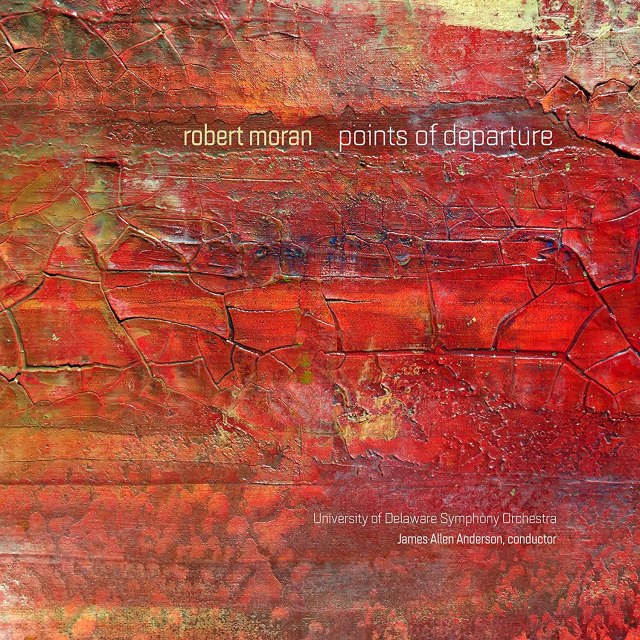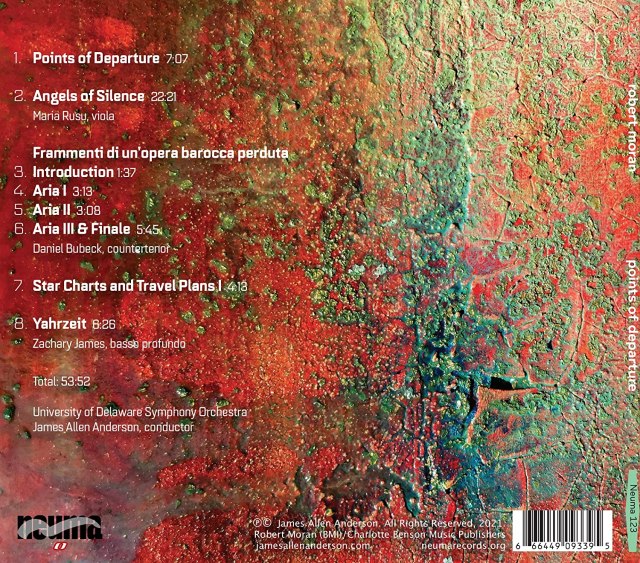
This is another in this first volley of new releases from Neuma. Philip Blackburn did fine service by reissuing the out of print the wonderful Argo recordings of Moran’s works and released two new collections from this all too little heard American composers as well as the gorgeous Trintity Requiem (2011) on Innova Records. He now continues his advocacy of this composer in the release on Neuma of two new Moran recordings, The second, Buddha goes to Bayreuth (2015) will get its own review shortly.
The present disc consists of five works, only one of which (Points of Departure) has been recorded before. Composition dates range from 1973 to 2017. Moran’s work is widely eclectic reflecting his early study with Second Viennese composer Eric Apostel, his M.A. studies at (the now lamentably defunct) Mills College where he studied with Luciano Berio and Darius Milhaud. HIs work ranges from graphic scores to post minimalist and post modern/neo-romantic styles doubtless influence at least in part by the various places he has lived (Vienna, Milan, Berlin, Portland, San Francisco, and Philadelphia where he now makes his home).
All of the works on this album are of the very listenable and sometimes unabashedly beautiful category. But these compositions belie the processes that underlie their structures and methods. What is most fascinating is Moran’s ability to use quasi aleatoric procedures (as in Star Charts and Travel Plans I) and produce results so gentle on the ear. This is a beautiful disc.

The all new recordings presented here begin with the titular Points of Departure (1993). It is a work for large orchestra which, according to Philip Gentry’s fine liner notes, is excerpted from a larger dance work. It is a rhythmic and exciting piece which demonstrates the composer’s mastery of the orchestra. One can easily imagine this accompanying choreography but it stands alone successfully as a concert piece.
The second track is Angels of Silence (1973) is seemingly anachronistic given it’s composition date when Moran’s output was arguably at it’s most experimental. Written during Moran’s time in San Francisco, it is one of a trilogy of works (between Messages from 1970 and Emblems of Passage from 1974). This trilogy followed on the heels of such grand experimental pieces as Thirty Nine Minutes for Thirty Nine Autos (1969) and Hallelujah (1971) for the city of Bethlehem, PA.
Here, despite the modernist use of chord charts for soloist and orchestra, we hear a very consonant piece which has an ethereal, gentle quality. To my ears it has much in common with the sound world of Stimmen Des Letzten Siegels (Voices of the Last Seal) (2001). The viola soloist, the Romanian-American Maria Rusu, handles her role beautifully with the university of Delaware Symphony Orchestra under the guidance of conductor James Allen Anderson. This writer’s fingers are crossed in the hopes of hearing the remaining two pieces of this trilogy in the near future.
Next up is the five movement Frammenti di un’ opera barocca perduta (2017). The title translates to something like “fragments of a lost baroque opera” and reflects Moran’s deep interest in early opera. The composer mentioned in an email exchange with this writer some years ago that he greatly enjoys listening to early baroque operas and this influence is in evidence here (in fact the texts he sets are texts from operas of this era). Scored for large orchestra with countertenor, a vocal artistry nearly extinct in the 20th and 21st centuries save for Philip Glass’ (with whom Moran collaborated in the fine fairy tale opera, The Juniper Tree) casting of the lead in his opera Akhnaten.
This gloriously lyrical suite can be sung by a soprano (and on first listen done before consulting program notes my guess was soprano) but it is sung as written by a truly fine vocal artist, Daniel Bubeck. The orchestral intro is followed by three arias (fast slow fast) followed by a brief orchestral epilogue. The piece is in some ways Moran’s Pulcinella, an homage to the past in the garb of the 21st century.
Star Charts and Travel Plans I (2016-17) is yet another example of the composer’s remarkable ability to use non-traditional notation to achieve his compositional goals. This rather meditative piece is very much in keeping with the overall sound of this fine release.
The disc ends with another vocal piece, Yahrzeit (2002-18), described by the composer as a “memory piece”. It has much in common emotionally with his wonderful Trinity Requiem (2011). Yahrzeit is a Jewish custom practiced on the annual celebration of the memory of the honored deceased. It is in memory of AIDS victim Michael Neal Sitzer whose life partner, poet James Skofield, wrote the beautiful text. Commissioned by friends of the couple, it was originally scored for male chorus and orchestra. It is presented here in a version for basso profundo, sung most movingly by Zachary James .
This is another major addition to the still too small discography of this great American composer. It is beautifully performed and recorded, a joy for fans of Moran’s work and a gift to listeners.
[…] but not least, as they say, Robert Moran: Points of Departure is another triumph of Philip Blackburn’s curation on Neuma records. I have personally been a […]
LikeLike
[…] Stylistically this work has more in common with Moran’s earlier mystery play, “Game of the Antichrist” than it does with the Requiem, though both are designed to take advantage of the resonant spaces of the cathedrals in which they were performed. This work relies more on the randomized chords in which Moran utilizes aleatoric structures in a way that are uniquely his. He did something similar in one of the pieces on another album reviewed here, “Points of Departure“. […]
LikeLike
Hi, excellent article, my name is Andrew Mullins. I would very much like to contact Mr. Moran.
My email is stanlaman527@gmail.com. 470-349-1901thank you
LikeLike
Thanks for reading. I don’t have contact info for Mr. Moran. But you isn’t try writing to Neuma records.
LikeLike
Thank you so much as always for bringing these gems to my attention. I’m putting this collection in my cue immediately.
LikeLike
As always, thank you for reading. I am a long time fan of Moran’s work and Philip Blackburn seems to be quite a fan as well. Stay tune for more to come from Moran and from Partch via Kenneth Gaburo. Some amazing releases lately.
LikeLike